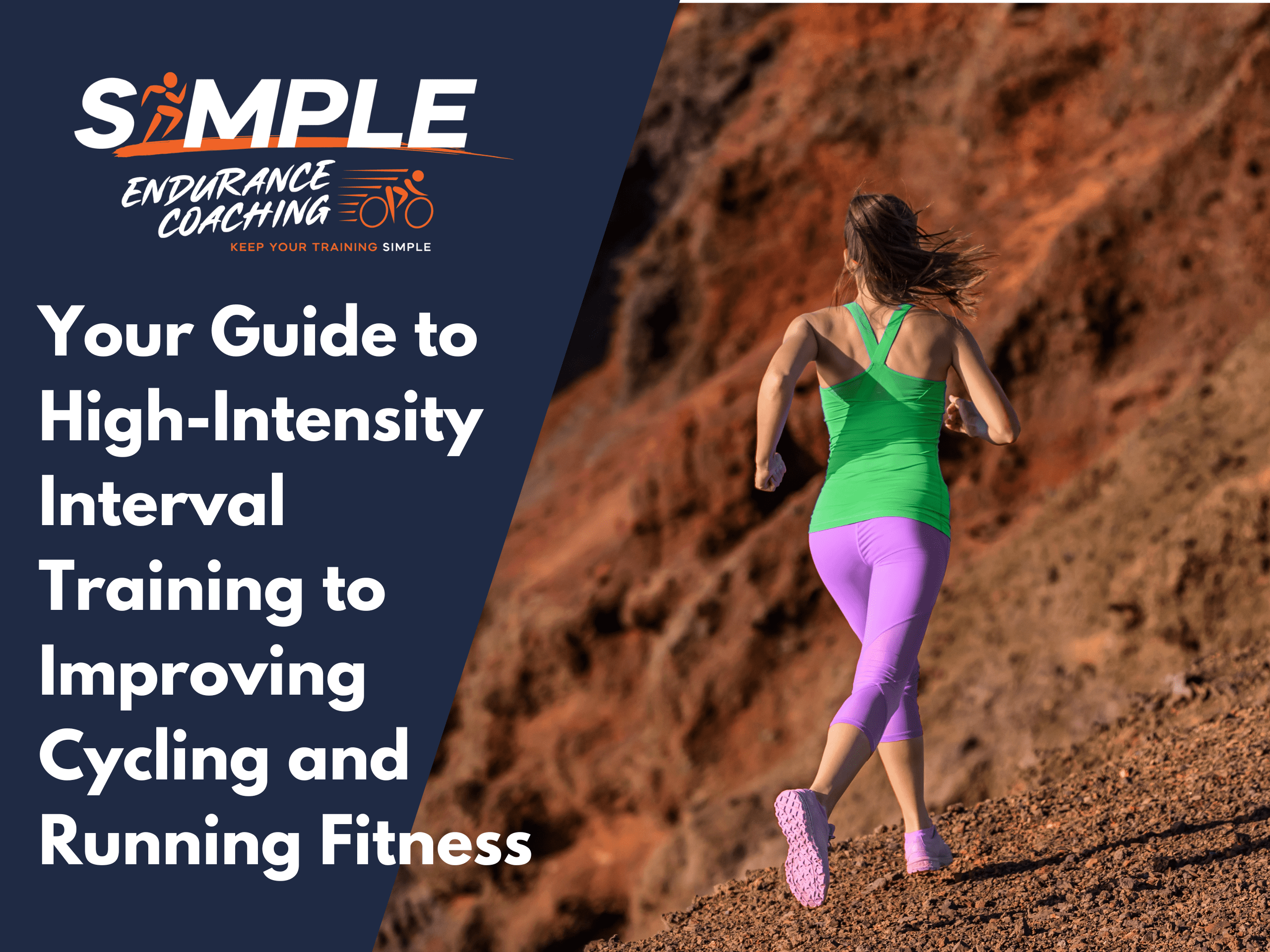Your Guide to High-Intensity Interval Training to Improving Cycling and Running Fitness
Are you looking for a way to take your fitness and performance to new heights?
Look no further than high-intensity interval training (HIIT)!
This powerhouse training method has taken the fitness world by storm, and for good reason.
Whether you’re a cyclist or a runner, HIIT can help elevate your endurance game like never before.
In this guide, we’ll break down what HIIT is all about, its benefits for cyclists and runners alike, and how much you should incorporate into your weekly training regimen.

What is high-intensity interval training?
High-intensity interval training, or HIIT, is a workout method that alternates between intense bursts of exercise, usually at or above your second threshold, and periods of rest or low-intensity activity.
Unlike traditional steady-state cardio workouts, HIIT pushes you to your limits by challenging both your aerobic and anaerobic systems.
The beauty of HIIT lies in its flexibility.
You can incorporate it into almost any form of exercise – from cycling and running to strength training.
The key is to push yourself during the high-intensity intervals, maximizing the adaptations you can bring.
During these intense bursts, your heart rate soars and your muscles work at maximum capacity.
This triggers a range of physiological responses that lead to increased cardiovascular fitness, improved muscle strength, enhanced endurance levels, and even fat loss.
In addition to its physical benefits, HIIT also offers time-saving advantages.
With shorter but more intense workouts compared to traditional methods, you can achieve similar or even better results in less time.
How does HIIT help cyclists?
High-intensity interval training (HIIT) is a powerful tool that can greatly benefit cyclists and improve their performance on the bike.
By incorporating short bursts of intense effort followed by periods of active recovery, HIIT workouts can push cyclists to their limits and help them become faster, stronger, and more efficient riders.
- One key way that HIIT benefits cyclists is by improving their anaerobic capacity. During high-intensity intervals, the body relies heavily on anaerobic energy systems to meet the increased demand for power. This not only helps build strength in the muscles but also trains the body to tolerate higher levels of lactate buildup.
- Furthermore, HIIT workouts enhance cardiovascular fitness and endurance. By repeatedly challenging your heart rate during intense intervals, you stimulate adaptations such as improved oxygen delivery and increased stroke volume. These changes allow your cardiovascular system to work more efficiently during longer rides or races.
- Additionally, HIIT can improve cycling performance through its impact on muscle fiber recruitment. The explosive efforts required in interval training activate fast-twitch muscle fibers that are responsible for generating maximum power output. Over time, this leads to greater neuromuscular efficiency and overall strength gains.
Incorporating regular HIIT sessions into your training program enhances both aerobic and anaerobic capacity – essential components for success in cycling events of various distances.
However, it’s important to note that every cyclist should tailor their HIIT workouts according to individual goals, current fitness level, and training focus.
How does HIIT help runners?
High-intensity interval training (HIIT) can be a game-changer for runners looking to improve their performance and fitness levels.
By incorporating short bursts of intense exercise followed by brief recovery periods, HIIT workouts push the body out of its comfort zone and challenge both aerobic and anaerobic systems.
- One key benefit of HIIT for runners is increased cardiovascular endurance. The combination of high-intensity efforts with short rest intervals helps boost the heart’s efficiency in pumping oxygenated blood to working muscles. This ultimately leads to enhanced stamina during longer runs or races.
- Additionally, HIIT can improve running speed and power. By engaging in explosive exercises such as sprints or plyometrics during intervals, runners stimulate fast-twitch muscle fibers that are responsible for generating quick bursts of energy. This translates into greater acceleration and improved overall speed on the track or road.
- Furthermore, HIIT sessions help build mental toughness necessary for enduring challenging races. Pushing through intense intervals teaches runners how to embrace discomfort and develop resilience when faced with fatigue or pain during long-distance runs.
Incorporating regular HIIT workouts into a runner’s training routine can lead to significant improvements in overall fitness levels, including increased VO2 max (the maximum amount of oxygen an individual can use during exercise), improved lactate threshold (the point at which lactic acid begins accumulating in the muscles), and enhanced muscular strength and power.
What are the key adaptations after HIIT workouts?
- One significant adaptation after HIIT workouts is an increase in aerobic capacity. By pushing your body to its limits during high-intensity intervals, you stimulate the cardiovascular system, forcing it to work harder to deliver oxygen-rich blood to your muscles. Over time, this leads to improved oxygen uptake and utilization by the muscles, enhancing overall endurance.
- Another adaptation is increased muscle strength and power. The intense efforts performed during HIIT sessions engage both fast-twitch and slow-twitch muscle fibers, leading to greater muscular strength development compared to traditional endurance training alone. This can be particularly beneficial for athletes looking to improve their sprinting abilities or explosive movements.
- Additionally, HIIT workouts have been shown to enhance fat burning and metabolic efficiency. The intense nature of these workouts creates an “afterburn” effect known as excess post-exercise oxygen consumption (EPOC), where the body continues burning calories at an elevated rate even after the workout has ended. This can result in increased fat loss over time when combined with a balanced diet.
- Moreover, HIIT has been found to improve insulin sensitivity and glucose regulation in individuals with diabetes or prediabetes. Regular participation in HIIT sessions can help regulate blood sugar levels more effectively by improving insulin function within the body’s cells.
The key adaptations that occur after engaging in regular high-intensity interval training include improvements in aerobic capacity, muscle strength and power, fat burning capabilities, as well as enhanced insulin sensitivity.
Incorporating HIIT into your weekly exercise routine can provide numerous benefits for both endurance athletes seeking improved performance and individuals aiming for better overall fitness levels!
How much HIIT should an everyday endurance athlete do in a week?
When it comes to incorporating high-intensity interval training (HIIT) into your weekly routine as an everyday endurance athlete, finding the right balance is key.
HIIT can be a powerful tool for improving fitness and performance, but it’s important not to overdo it.
You can build excess fatigue that can affect the rest of your training.
And remember, volume matters. You need a program that mostly favors long, easy endurance miles.
The amount of HIIT you should do in a week depends on several factors, including your current fitness level, goals, and overall training volume.
It’s generally recommended that endurance athletes limit their HIIT sessions to 1-2 times per week.
Integrating too much HIIT into your routine can increase the risk of injury and lead to overtraining.
Remember that while these workouts are effective for building anaerobic capacity and improving speed, they also place significant stress on the body.
To maximize the benefits of HIIT without risking burnout or injury, consider alternating your high-intensity sessions with lower intensity workouts like endurance or recovery runs or rides.
This will give your body time to adapt and recover between intense bouts of exercise.
Listen to your body and pay attention to any signs of fatigue or excessive soreness. If you’re feeling consistently tired or experiencing nagging pains, it may be a sign that you need to dial back on the intensity or take additional rest days.
Incorporating variety into your training regimen is also important for long-term success. Don’t solely rely on HIIT as your primary form of exercise; include other types of workouts such as strength training and longer endurance sessions for a well-rounded approach.
Remember that every individual is different, so what works for one person may not work for another.
Experiment with different frequencies and durations of HIIT sessions until you find what feels optimal for you personally.
What does the research say about HIIT for endurance athletes?
Research has shown that high-intensity interval training (HIIT) can be highly beneficial for endurance athletes looking to improve their performance.
Studies have demonstrated that incorporating HIIT into an endurance athlete’s training routine can lead to significant improvements in aerobic and anaerobic fitness.
- One study published in the Journal of Applied Physiology found that just six sessions of HIIT over a two-week period improved cyclists’ time trial performance by approximately 6%.
- Another study published in the Journal of Strength and Conditioning Research showed that runners who included HIIT workouts in their training regimen experienced enhanced running economy and increased lactate threshold.
- Furthermore, research suggests that HIIT can elicit favorable adaptations within the body. These adaptations include increased mitochondrial density, improved oxygen utilization, enhanced muscle buffering capacity, and greater glycogen storage.
- The optimal amount of HIIT for everyday endurance athletes will depend on various factors such as individual fitness level, goals, and recovery ability. However, most studies recommend incorporating 1-3 sessions of HIIT per week into an overall training program.
Research supports the inclusion of high-intensity interval training in an endurance athlete’s regimen to improve both aerobic and anaerobic fitness.
However, it is crucial to strike a balance between intensity and adequate recovery to avoid potential drawbacks associated with excessive HIIT.
Need more?
GET A FREE Core Strength and Stability training video when you opt-in to receive my weekly blog posts about what works in endurance sports.
SIGN UP FOR A Virtual Coffee so we can discuss your goals, ask questions, and talk about making your endurance training more effective, fun, and Simple.
Paul Warloski is a:
- USA Cycling Level 2 Coach
- RRCA Running Coach
- Training Peaks Level 2 Coach
- RYT-200 Yoga Instructor
- Certified Personal Trainer






3 Responses